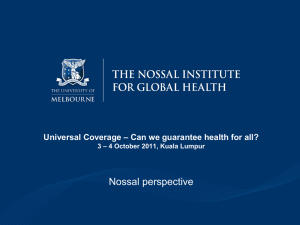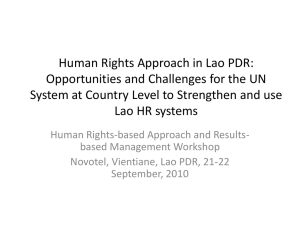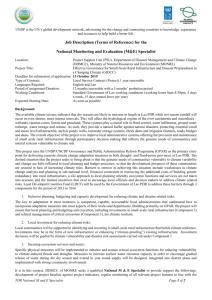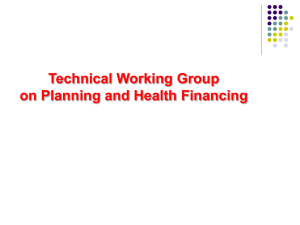Project Name - Documents & Reports
advertisement
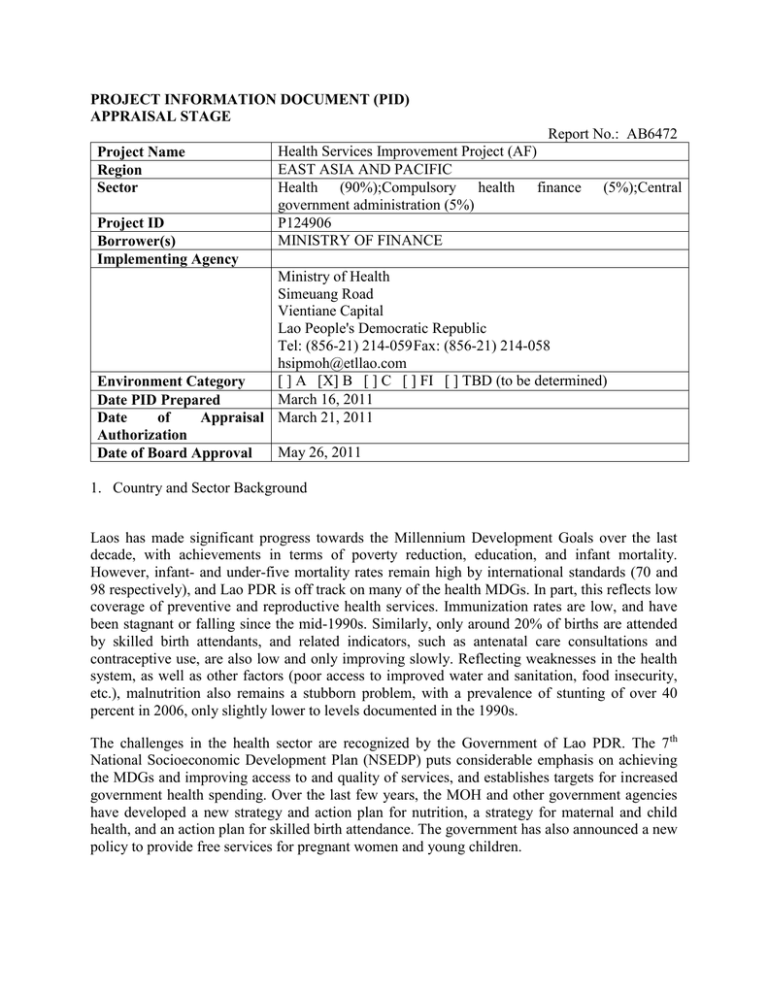
PROJECT INFORMATION DOCUMENT (PID) APPRAISAL STAGE Report No.: AB6472 Project Name Region Sector Project ID Borrower(s) Implementing Agency Health Services Improvement Project (AF) EAST ASIA AND PACIFIC Health (90%);Compulsory health finance government administration (5%) P124906 MINISTRY OF FINANCE (5%);Central Ministry of Health Simeuang Road Vientiane Capital Lao People's Democratic Republic Tel: (856-21) 214-059 Fax: (856-21) 214-058 hsipmoh@etllao.com [ ] A [X] B [ ] C [ ] FI [ ] TBD (to be determined) Environment Category March 16, 2011 Date PID Prepared Date of Appraisal March 21, 2011 Authorization May 26, 2011 Date of Board Approval 1. Country and Sector Background Laos has made significant progress towards the Millennium Development Goals over the last decade, with achievements in terms of poverty reduction, education, and infant mortality. However, infant- and under-five mortality rates remain high by international standards (70 and 98 respectively), and Lao PDR is off track on many of the health MDGs. In part, this reflects low coverage of preventive and reproductive health services. Immunization rates are low, and have been stagnant or falling since the mid-1990s. Similarly, only around 20% of births are attended by skilled birth attendants, and related indicators, such as antenatal care consultations and contraceptive use, are also low and only improving slowly. Reflecting weaknesses in the health system, as well as other factors (poor access to improved water and sanitation, food insecurity, etc.), malnutrition also remains a stubborn problem, with a prevalence of stunting of over 40 percent in 2006, only slightly lower to levels documented in the 1990s. The challenges in the health sector are recognized by the Government of Lao PDR. The 7 th National Socioeconomic Development Plan (NSEDP) puts considerable emphasis on achieving the MDGs and improving access to and quality of services, and establishes targets for increased government health spending. Over the last few years, the MOH and other government agencies have developed a new strategy and action plan for nutrition, a strategy for maternal and child health, and an action plan for skilled birth attendance. The government has also announced a new policy to provide free services for pregnant women and young children. 2. Objectives The objective of the project is to assist the Lao PDR to increase utilization and quality of health services for poor women and children, in particular in rural areas in Project Provinces 3. Rationale for Bank Involvement With the approval of a new policy to provide free services to pregnant women and children under five, the GOL has requested Additional Financing (AF) to HSIP to expand the scope of the free delivery pilot, while also introducing financing for child health services and continuing support to human resource development and service delivery capacity. Support in these areas is expected to enhance the development impact of the Project, and also improve the prospect that key programs and interventions will be sustained. While the team considered other means of supporting the MOH, including preparation of a new Project, given that the core elements of the requested support comprise scaling up or modifications of ongoing support under HSIP, utilizing AF was deemed to be the most cost-effective approach to respond to the request from the GOL. The additional financing will continue to support the second objective of the Country Assistance Strategy (CAS) through strengthened public financial management and service delivery capacities and targeted poverty reduction programs (the 2nd of 4 objectives of the 2005 CAS). The support also aligns with the third objective of the CAS, namely to adopt a strategic approach to capacity development and partnerships for better National Growth and Poverty Eradication Strategy results; this has included stronger capacities to develop and implement priority sector strategies, greater involvement of communities, and outreach with civil society and mass-based organizations. A new Country Partnership Strategy (CPS) is currently under preparation, which is expected to maintain achievement of Millennium Development Goals (MDGs) 1, 4 and 5 as priority areas for World Bank engagement. 4. Description The original IDA Grant became effective on February 22, 2006, with financing of SDR 10.4 million (US$15 million equivalent). The Project was initially implemented in eight central and southern Provinces, but the coverage has been reduced due to the subsequent merging of two Provinces and the initiation of support from Lux-Development to the central Provinces. AF in the amount of US$10 million will support expanded activities that scale up the impact and development effectiveness. The Project will be restructured (first order) in conjunction with the preparation of additional financing (AF) to adjust the formulation of the Project Development Objective (PDO), and to reflect the scale-up of some activities, and modifications to implementation arrangements aimed at enhancing the Ministry of Health (MOH) ownership of the Project. The original IDA Grant will be extended by 36 months in line with the closing date proposed for the additional financing. The Project will be co-financed in the amount of US$2.4 million from the Health Results Innovation Trust Fund (HRITF). The Project has three components. Improving the quality and utilization of health services. This component will support the improvement in accessibility and quality of basic health services. A key feature of the component is to build the capacity of Districts for developing and executing comprehensive health plans. A minimum package of services, drawn from the MOH’s Minimum and Complementary Package of Services is to be delivered at each level. In addition to the activities currently supported by this component, support will be provided for free child (under five) health services and Project Provinces will also be specific beneficiaries of support. Strengthening institutional capacity for health service provision. This component will build capacity to improve service delivery, principally at the District and village levels. The target group includes health service providers as well as management teams at Central Provincial and District levels. Capacity building under this component includes training for health providers, and training for Project management. Improving the equity, efficiency, and sustainability of health financing. This component will finance the roll out of the HMIS from the Central level, down to Health Center level, and includes technical assistance to work with the MOH for the development of staff training, and the necessary equipment to analyze, effectively use, validate and audit the data. In order to explore mechanisms for increasing health service access by the poor, this component will finance the design, and piloting of a mechanism (including the provision of grants) for non-governmental organizations to pay public service health providers directly for covered health service delivery and related costs. Additional Financing will support additional and expanded activities that scale up the impact and development effectiveness of the original Project. Specifically, the following activities will be supported: (a) scaling up of programs to reduce financial barriers to health services; (b) continued financing of recurrent costs at province, district and health facility level; (c) focused investment in human resource development; and (d) support to equipment and facility upgrading at district hospital and HC level. 5. Financing Source: BORROWER/RECIPIENT IDA Grant Total ($m.) 0 10 10 6. Implementation The arrangements for implementation put in place under the parent Project took into consideration the capacity constraints facing the MOH at the time of design, and these have been satisfactory. With a view to shifting away from project management units and to better align with the Paris and Vientiane Declaration, the institutional arrangements for the AF are designed to put activities supported from this financing under the direct responsibility of the technical department of the MOH which is responsible for the activities, and providing capacity support within the MOH. The overall policy direction will continue to be provided by the existing Steering Committee within the MOH. While the coordination and management will continue to rest with DPF, the DG, instead of a consultant, will serve as the Project Director. The DG will be supported by an advisor who will be contracted under terms of reference acceptable to the World Bank. This support will be replicated in the technical departments which have responsibility for activities financed from the AF. The DPF will also be augmented by an administration officer, an accountant, a cashier, a financial management specialist and procurement support; all of these consultants, who will be contracted under terms of reference acceptable to the World Bank that include measurable capacity building efforts for the MOH. Each Province (or is it District) which will receive funds from the AF will be supported through the provision of a financial management consultant, contracted under terms of reference acceptable to the World Bank. The role of these consultants will include building the capacity of the Provinces/Districts to which they are assigned 7. Sustainability The Government is committed to increasing health spending over the coming years, in part to finance the policy of free services for pregnant women and children that the project will support. The MOH has been closely involved in defining both the original project and the activities under additional financing. Given the ownership evidenced, and HSIP’s support to Government’s longterm plan for the sector, it is likely that the initiatives will be sustained. 8. Lessons Learned from Past Operations in the Country/Sector The Project has contributed to significant achievements. Through the District Grant Allocation (DGA), the Project has provided recurrent financing to districts and health centers to support outreach services, including immunization, in the context of a very low level of facility attendance. The Project has supported a broad range of training activities, including the expansion of two new cadres of health care workers to address human resource gaps and promote improved opportunities for ethnic minority representation in the health profession (e.g. Primary Health Care Workers have been recruited from rural communities, trained and placed at local health centers, and Community Midwives have been trained to improve the quality of midwifery services). Village Health Committees, Village Health Volunteers and Traditional Birth Attendants have been trained and provided with Village Drug Kits to improve communitybased health services. The Project’s support to the development of an HMIS has contributed to increased availability of information on health services and improved timeliness and completeness of reporting on health service utilization and outcomes. The Project has also supported innovative health financing pilots, including the development of a Free Delivery Pilot (in two districts) to assess the feasibility and impact of reducing the financial barriers to facilitybased delivery, and an expansion of HEFs to provide user fee exemptions for poor households. These pilots have helped shape emerging health sector policies related to the recent decree promulgated by the GOL to provide free maternal, neonatal and child health (MNCH) services as well as efforts to develop a comprehensive national health insurance system. Finally, the Project has led to improved infrastructure for both medical training and service delivery facilities at both the central and decentralized level. Despite the successes, the health sector in Lao PDR faces a number of challenges. Health service utilization rates remain very low by international standards, and limited health staff capacity, lack of equipment, and drug stock-outs undermine the quality of services that are available. Implementation of integrated outreach services is uneven, partly due to a proliferation of vertical programs supporting narrowly focused activities. Human resource development has predominantly consisted of short-term courses conducted on an ad hoc basis, reflecting the absence of a comprehensive system for planning and managing the professional development for health sector staff. While the pre-service programs have made a significant contribution to an increase in the quantity of qualified health professionals, many of the graduates have yet to be officially employed as civil servants due to a restriction on the quota (number of funded position) provided to the MOH. 9. Safeguard Policies (including public consultation) The original Project triggered the Indigenous Peoples safeguard (OP/BP 4.10). The project preparation of the original HSIP included a Social Impact Assessment (SIA) to examine the effects of the proposed Project on beneficiaries, focusing in particular on indigenous peoples and other vulnerable groups. The SIA concluded that while the Project had no particular negative impacts, positive impacts would depend upon the degree to which increased efforts to include non-Lao ethnic groups participation in the health care system could be successful. To this end, the EGDP aimed at providing a strategy and a programmatic approach to enhance the inclusion of different non-Lao ethnic groups in the HSIP. The EGDP was in compliance with policies of the Lao PDR on ethnic groups and with the World Bank’s then Operational Directive 4.20 on Indigenous Peoples. Most of the elements under the EGDP have been implemented. Moreover, many of the project activities have had direct benefits for non-Lao ethnic groups. First, the project has supported recruitment of students from rural and remote communities and provision of special training aimed at students coming from diverse linguistic backgrounds who might have difficulties in reading and writing Lao. Second, financing of outreach services is specifically aimed at expanding coverage of key health services, such as immunizations, in remote communities with a high concentration on non-Lao households. Finally, the project has financed the cost of health services for the poor and pregnant women on a pilot basis. Available evidence suggests that a significant proportion of benefits have accrued to non-Lao groups, most likely reflecting the use of geographic and poverty targeting. The AF will continue to operate in the same geographical areas as the original Project, and the Indigenous Peoples safeguard (OP/BP 4.10) will be triggered under the AF. Given that the AF will support activities that are already implemented under the original project, HSIP AF will continue to benefit rural and remote communities where non-Lao ethnic groups are concentrated. The EGDP remains a relevant instrument for ensuring that project activities benefit all ethnic groups in the project areas. Consultation with communities in the project provinces (in March 2009, as part of the preparation of the Community Nutrition Project) confirmed that the provision of free services was fully supported by women and other community members. However, community members noted the need to ensure that cultural practices are weighed and given credence without making value judgment as to their efficacy as this can exacerbate the preconceived notions of ethnic minority inferiority. The HSIP has supported a range of civil works at central, provincial, and local level, including construction or rehabilitation of central, provincial and district hospitals; health centers and training institutions. Although civil works accounted for a significant share of project financing, the scale of civil works is modest relative to the scale of the overall health infrastructure in the country. The project triggered the World Bank’s environment safeguard policy (OP/BP4.01) with a category B rating. An Environmental Assessment was conducted in June 2004 and the subsequent Environmental Management Plan is dated September 2005. Under HSIP AF, only minor refurbishment of health centers and training institutions will be supported, with no new construction envisaged.The overall Project risks are not expected to change in any substantial way and it is proposed that the current categorization of “B” be retained. The EMP remains adequate for managing the risks associated with the minor civil works planned under AF; no additions or revisions are required. 10. List of Factual Technical Documents Govt. of Lao PDR: HSIP Project Implementation Plan – (Draft) Govt. of Lao PDR: HSIP District Manual of Operations (Draft) Govt. of Lao PDR: National Growth and Poverty Eradication Strategy Govt. of Lao PDR and JICA: Health Master Plan - Volumes 1-4 Case Western University: Report on Medical Education in Lao PDR Belgian Technical Assistance: Integrated Community Health Centers: Implementation Manual: Volumes 1 and 2 BTC: Support to health sector reform in the Provinces of Vientiane and Savannakhet Formulation Report IndoChina Research: HSIP: Baseline Survey Report Chamberlain, J., Social Impact Assessment (Revised). May 2004 Chamberlain, J., Ethnic Group Development Plan. May 2004 EVS Consultants. Environmental Assessment. June 2004 11. Contact point Contact: Phetdara Chanthala Title: Health Specialist Tel: 5784+6210 / 856-21-450-010 Fax: Email: pchanthala@worldbank.org Location: Vientiane, Laos (IBRD) 12. For more information contact: The InfoShop The World Bank 1818 H Street, NW Washington, D.C. 20433 Telephone: (202) 458-4500 Fax: (202) 522-1500 Email: pic@worldbank.org Web: http://www.worldbank.org/infoshop
